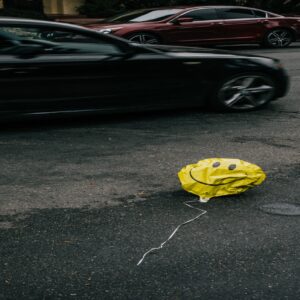The first thing you might notice when watching Suburban Slaughter is the flashing red thunderbolt on the corner of the screen; the camcorder is almost out of battery, and the characters are almost out of time. It starts with blurred static until a moment of clarity reveals two boys crushed by compression. Their bright shirts and blue jeans are reduced to their shapes, made silhouettes by the pale sunlight. When the camera readjusts, it centers on the inkblot between them—impossibly dark, like dead pixels on the screen. Around it, bone-white trees fill the frame, naked of their fallen leaves, which scatter into the air with plumes of dust as the creature writhes, whimpering and beckoning the boys closer. Yet, it remains tethered to the earth in a beartrap one of the boys steps toward, asking the others if it’s okay to set it free.
This cold open has become one of the most iconic in found footage horror history. While it follows in the tradition of other low-budget features from the early 2000s derivative of The Blair Witch Project, 2004’s Suburban Slaughter remains noteworthy for its spontaneity. The film opens without a title sequence or any credits, and the shaky cam and dying battery give this moment a sense of urgency as if these are ordinary people who came across a spectacle entirely underprepared. This is because it’s the truth. Before the cult following, before the marketing, and before the ensuing tragedy, Gabriel Domingo, Arturo Iglesias and Ignacio Menendez found a wounded creature in the woods and tried saving its life before everything went to hell.
Arturo, wielding the shaky camcorder, approaches the creature with a digital zoom. We can hear the revving of the camera as the tangled nest of teeth and legs becomes all we can see. At a glance, the body in the beartrap appears like a dog, but with legs that melt into hooves and count far too many. The snout is as long as a horse’s, with dagger-teeth bared along the sides. Somewhere in this darkness, its eyes search for a way out. “It’s hurt,” Gabriel says, “It needs help, and if we don’t help it, nobody else will.”
At the sight of Gabriel’s devotion, critics, such as Arthur Mackey, conclude the monster somehow controls him, perhaps by the frequency of its whimpers or by some hypnosis off-screen. While we don’t spend enough time with him to see a change in personality, the other boys approach him with a disturbed distance. Ignacio walks with his arms outstretched, as if approaching a wild animal, while Arturo simply zooms into his face, searching for details in the pixelated static. The curves of his chubby, youthful face are carved by lines along his forehead and beneath his eyes, aging him into someone who looks both fifteen and fifty. His head is downturned, casting a shadow over his eyes and Mackey interprets this uncanniness as a mask obscuring a sinister manipulation by the creature. In his essay, “Suburban Slaughter: Manipulation and Media,” he argues this is evidence of the film’s allegorical reading of, as he puts it, the manipulation of the American public during the Bush administration. He writes:
The creature lurks undetected, shrouded underneath a veil of a forest, and then is masked by Gabriel’s friendliness and empathy. This protects the suburbanites just as the resurgence of American patriotism protected well-meaning white Americans from the devastating consequences of the invasion of Iraq.
If the ‘suburbanites’ are supposed to be “well-meaning white Americans,” then Mackey must’ve seen the movie colorblind. Everyone appearing on-screen is Latin American, with Mexican, Salvadorean, and Guatemalan flags hanging from their rooftops. While I want to support any interpretation a work of art receives, I don’t want it to come at the cost of mischaracterizing what we see. I will dive into this concept deeper in this article, but for now, Gabriel lets out quiet sobs into his crossed arms, shielding himself from the camera by turning around, displaying the bright green 10 on his yellow soccer jersey. Ignacio looks back to Arturo, behind the camera, with raised shoulders and an expression of concern as the creature continues thrashing behind him.
Ignacio approaches Gabriel with large steps, letting his necklace of a wooden shark tooth dance along his neck. We see the fuzzy worm of a mustache wiggle as he whispers words just out of reach, but this seems to soothe Gabriel. They reach arms around each other, a soft embrace Arturo zooms out from, as if the camera itself is uncomfortable with this intimacy. There’s a gentle smile on Gabriel’s face as he remembers his mother is making them pupusas and he then leads them inside his house at the edge of the woods.
The shining finish of the wooden house reflects washed out blues into the eye of the camera, but in person, we can only imagine how bright the colors must’ve been. The entire movie is characterized by this gray aesthetic, not uncommon for horror cinema from the mid-2000s, but here, it’s because of the camcorder’s limitations, sucking the sunlight and life out of every scene.
Inside, Ignacio comments on how delicious the kitchen smells. Gabriel’s mother is flipping pupusas on the comal, and when she hands the boys some on paper plates, we can see the cheese spill from their stuffed sides. While eating, Arturo sets down the camera to charge but leaves it shooting. This is one of the few times we see him in front of the camera, and even here, his back is to the screen, only revealing his red shirt and almost-black jeans.
The scene of the boys eating lunch in Gabriel’s living room performs the work of introducing us to the people we’ll remain with for the rest of this tragedy. They’re silent at first, chewing and ignoring the belting whimpers until Ignacio breaks the silence. “Doña Domingo, these pupusas are the best I’ve ever had.” He releases a comically loud “Mmmmhmmmm” as Arturo’s bouncing shoulders barely hide his snickering laughter. Gabriel doesn’t react and doesn’t reach for his food; he lets it grow cold on his plate.
Arturo waves a hand in front of his glazed stare. “You alright?”
Gabriel shrugs. “Not really. What even is that thing?”
With a mouthful of pupusa, Ignacio calls out: “Some wolf.”
“You can’t be serious.”
“Even if it’s not, we can call animal control, and then it’s out of our hands; we won’t have to worry about it anymore.”
Arturo nods. “It looks rabid; it’d be better not to mess with it.”
“But it looks hurt,” Gabriel replies, “who knows what they’d do to it.”
“Probably nurse it back to health?”
“Yeah,” Ignacio says, “it’s not like they’re going to put it down or anything.”
At this, Arturo slaps Ignacio’s leg. Gabriel’s face falls into shadow, and he remains quiet as the boys eat the rest of their meal. On the wall behind them, we see pictures of smaller boys cradling an even smaller black puppy. There are dog toys on the floor, but when they entered the house, there were no barks nor any pitter patters of paws. Augusto Sarmiento wasn’t the first critic to recognize Gabriel’s recently deceased dog as the source of his empathy for the creature, but he added to this theory by speculating if it might’ve been reanimated. Sarmiento acknowledges the absurdity since their similarities solely extend to the color of their fur, but even if the creature only reminds Gabriel of his former dog, it would be enough of a reason to understand why he does what he does.
As the other boys finish eating and Ignacio takes their plates to the kitchen, Gabriel slumps over into quiet sobs. Yes, maybe Mackey is right, and Gabriel is being manipulated, but the truth of the matter is we’ll never know, and I find it easier to believe this heartbroken boy feels more pity than his body can bear when he rushes outside back in front of the beast.
Before Arturo can unplug the camera from its charger, there’s a screech distorting the microphone. Knotted thuds accompany a yelp from the kitchen and Arturo rushes out, blurring the yellow walls into the screen door into the white grass outside. Blurred blotches of light form an image of Gabriel forcing the trap open, knees to the ground, as the creature’s snout bites into his neck. Torrents of blood spill onto his clothes, feeding the arid grass as the other boys beg him to stop. By the time the words reach him, his body slumps over and releases the monster.
This is the first time we get a good look at the creature, towering above Gabriel’s limp body and tearing his flesh. Similar to the baby in David Lynch’s Eraserhead, there have been long-standing debates on how the micro-budget crew created such a horrifyingly real creature. It stands over the height of a coyote with shimmering black fur that shines iridescent like an oil slick. It still wears its toothy horse snout and multitude of legs, almost hidden by the lengthy fur, appearing like a moving streak of soot. However, we get all this from a passing impression. Arturo and Ignacio rush inside, pushing Gabriel’s mother back into the house so she doesn’t have to see the carnage. Here, the camera dangles from Arturo’s wrist and shows us blurring failure. She breaks through them, and we have to sit with the uncomfortable image of Ignacio turning the lock on the door as we hear her cries for her son just before the creature tears into her, too.
Ignacio reaches for the landline and dials 911, begging whoever hears him to send anyone they can. “Two people are dead! No, some wild animal. No, I don’t know where it’s heading. Okay. Okay. Okay.”
He hangs up, and Arturo asks if he should keep recording. Sweat sparkles on Ignacio’s forehead as he looks behind the camera, thinking. Maybe thinking of what to answer with, if there is any purpose in recording an unpreventable tragedy or maybe thinking of how Gabriel’s final moments are trapped in the camcorder. Maybe he’s finally caught a glimpse of the title and wants his final moments to be caught by the camera, too. Ignacio tells Arturo to not stop recording no matter what.
This line draws a direct parallel to 2007’s [REC] whose characters repeat the sentiment and use their camera as a tool of resistance. While Ignacio wields the same determination to survive on screen, the statement itself sounds like an admittance of his doomed fate, as if the only way to continue living is through the camera. In her seminal book, Living Pictures, Melissa Bermudez argues that cinema is a form of pseudo immortality, allowing us to live alongside people who have died and see them as living. We no longer have to remember the way someone acted or appeared or what they said; we can simply rewind and live on alongside them. She uses Suburban Slaughter as an example of this immortality, citing Ignacio’s hesitation as him realizing this in real time. Although he may not survive the next twenty-four hours, if he remains on camera, he’ll live forever.
This isn’t always a good thing, of course. It has become a popular meme among a niche circle of film fans to post pictures of Gabriel, somberly kneeling over his pupusas, edited into scenes in other movies, just before tragedy strikes. He’s been edited into scenes from The Thing (1982), Goodfellas, Grave of the Fireflies, and any other movie you’ve seen with tragedy lurking around the corner. He’s become an omen, a token of everything terrible to come, which is a form of immortality that doesn’t do justice to the life behind the camera. I don’t imagine Ignacio considered this a remote possibility when he asked Arturo to continue recording, but I also wonder who he imagined would see this footage.
The viral marketing behind The Blair Witch Project was a central part of its initial intrigue and lasting success. There was a myth around the movie; at the time, audiences didn’t know whether or not its narrative was fictionalized, and this ambiguity resulted in a thunderous arrival, becoming one of the most profitable movies of all time. Clearly, this form of advertising would be imitated, and while Paranormal Activity has been the most, and debatably only, successful film to follow this marketing format, Warner Bros. attempted the same thing a few years earlier with Suburban Slaughter.
Months before the movie was released, whispers on web forums hummed of a video recording of a town’s massacre. From bigfoot to Lovecraftian abominations, these rumors avalanched in their absurdity to the point it was impossible to tell who was promoting the movie and who was having fun with the premise. Users of the now-shut down Undercurrent Cinephiles web forum disapproved of Warner Bros.’s use of the grassroots marketing tactic when it had the backing of one of the largest companies working in movies. This controversy never left its niche internet community and by the time the movie came out, members from the forum had already moved on to the next upcoming release. As someone who lurked on those forums, I was surprised to see how quickly interest fizzled out, especially since the first trailer marketed the movie as a documentary of the massacre of San Alejandro, New Mexico, a town that no longer exists.
I have to imagine that at some point, the town did exist, but its name is never mentioned in the movie and doesn’t appear on any digital or paper maps from today or as far back as the late 1990s. The synopsis for the movie on IMDb mentions San Alejandro and through the Internet Archive’s Wayback Machine, we can see the original webpage for the movie also mentions San Alejandro. The simple answer is that it is a fictional town in a fictional movie, which is not uncommon, but this is muddied with recent revelations, indicating this film might not be as fictional as we initially believed.
Just under an hour south of Los Alamos, the atomic town that has recently received a resurgence of intrigue thanks to Christopher Nolan’s Oppenheimer, San Alejandro remains a ghost of the town it was just a few decades ago. Not that the town was ever that big, but there was once a bubbling community there. It was founded recently enough for it not to have needed a graveyard, but there was already a k-12 school and a courthouse, and while it would be a stretch to call it the suburbs, there were clusters of homes stretched along the edge of town. I know because I visited it myself.
In the Fall of 2023, as research for this article, I made the drive to San Alejandro. If you search up the town today, you won’t find a conventional destination but instead links to a movie set of the same name. Before entering the town, there’s a bright blue ticket booth with posters of movies shot here, including Suburban Slaughter, Johnny Booth’s Nothing Further West, Evan Miller’s The Final American Paradise, and John Smith’s Back When We Were Wild. Needless to say, every production in San Alejandro after Suburban Slaughter has been led by white actors and directors, usually in smaller passion projects for celebrities who no longer have the star power they did a few decades ago. Some of the houses in the ‘suburbs’ have been remodeled to look more antiquated or have been fitted to have breakaway glass and smashable props, but these redecorations do not remove the ghosts from the floorboards. Every death captured in Arturo’s camcorder isn’t performed by an actor or an extra; these deaths belong to fathers, wives, mothers, children, and anyone else trapped in the jaws of the camera.
After the initial carnage, Arturo and Ignacio wait with heavy breath. They remain pressed against the front door until a knock from a police officer sends them standing at attention. They tell him everything, speaking over each other to the point it’s hard to make out the words. The officer doesn’t like having the camera on him; it makes him think he’s being pranked, so they put it away and, for the first time, stop recording.
When the screen lights back up after a breath of darkness, Ignacio is scolding Arturo, who is saying, “Okay, okay, it won’t happen again.”
It’s impossible to know what happened between these moments, but they are now outside, beneath a pale sun that burns everything white. They’re running behind the houses of their neighborhood, by chain link fences and dirt paths. The whistling wind clips the microphone, droning out Ignacio’s words—all we can hear is “garage” and “safe.” They’re already running—the camera loosely following Ignacio’s back, bobbing and blurring to a dizzying extent—but they burst into a full-on sprint at the sounds of screaming and gunfire in the distance. Sirens roar across town, and they won’t stop singing until the movie ends.
On their sprint to the garage, they pass mangled corpses, hardly noticed by the camera, but the boys can’t ignore them. “Was that Fermina?” Arturo asks between heavy breaths, but his question goes unanswered. “Michael? Ernesto? Matthias?” We see the blurring remains of bodies, some missing limbs or their jaw with the occasional stray arm or leg rotting in its own blood. They run out of names as the bodies pile up, and when Ignacio walks too close to a corpse, his sneakers leave a red trail behind him.
When they finally arrive behind the yellow house, Ignacio lifts the white garage door and slams it behind Arturo. He tugs a thread dangling from the ceiling, and a dim bulb illuminates the room. A pan by Arturo reveals the man cave. A pool table sits in the center, beneath a flag for the Texas Cowboys, with a CRT TV resting neatly in the corner. On the opposite side, beside an unseasonal Christmas tree, a fridge rumbles, and Ignacio pulls bottles of water for the two of them, pouring some over his hair. Arturo bends over to catch his breath as Ignacio presses the buttons on a gray safe and gently pulls it open, revealing a small case requiring another combination. Inside, sit two handguns, one for each of them. Ignacio hands one to Arturo, instructing him how to use it and while there’s a sense of familiarity with the weapon, he uses all the wrong terminology.
Gunfire and screams send them both ducking. They already know the creature is close, but it feels even closer with the sound of a shattering window. They follow the sound with guns in hand, reaching the living room littered with twinkling shards beneath a police officer with its head missing. When they look outside, the creature looms, having grown to the size of a rhino with legs long enough for it to stand above a police cruiser. It stomps into the glass and gurgles blood across the pavement before running its snout into a windshield to gnaw on more officers. Ignacio is ready to shoot at the creature, but Arturo stops him, saying if the police can’t stop him, what makes him think they can?
The boys remain in the hallway beside the door frame. Here, Igancio’s expression shifts, and his confident demeanor melts into welling tears. He mumbles a prayer for his parents and his safety, and Arturo joins in. Together, they whisper until the apocalyptic roar of helicopter blades cuts through the noise. An explosion makes the entire house tremble, and the groans of wooden beams hints the foundation could collapse at any second. Without hesitating, the boys climb out the shattered window into the domestic battlefield ahead. Gray trucks park on the lawns with soldiers in military fatigues riding on top of them, firing rifles at the beast. Rockets soar overhead, and the eye and tiny microphone of the camcorder cannot contain all this fury. Smoke oozes out of the creature, spilling like blood as the glow around the fire feels almost electric. Men shout as a stray bullet pierces Ignacio’s arm. He yelps but we cannot hear it, we can only witness the boys sprinting into the overgrown grass in a gap between houses. Here, we finally see everything. The creature has grown into a colossus, towering larger than a house and leaping into the air, attacking a helicopter and knocking it out of the sky and into a puddle of screams off camera. It stands in the crumbling remains of Ignacio’s home, tossing wooden beams and shards of bricks everywhere. The bullets seem to be simply sinking into the skin of the beas,t and its once-covered eyes now display brightly like haunted rubies.
The camera finally returns to Ignacio, clutching his arm where he was shot. His face is wet with sweat and tears. “I don’t want to die,” he whimpers again and again like a spell until words lose all meaning.
Arturo spots an ambulance parked on the sidewalk between them and the monster, and he lifts Ignacio by the hand and almost drags him to the paramedics. There’s so much noise it’s hard to make out what anyone says. We see mouths and static and hear the words ‘save us,’ but the spell doesn’t work. Just as the screen begins flashing red with another warning of its low battery, the ambulance spirals from what must be an impact from the creature. The screen becomes noiseless blurs of gray, red, and brown. The sound cuts out and when I first saw this in theaters, opening night in 2004, I remember the collective gasps I heard from the scattered members of the audience. When the blur stops, the camera sits on concrete. An arm connected to Arturo’s red sleeve limps on the right side of the frame, motionless with rivers of blood pouring down its fingers. Smoke spools into the pale sky, and the ambulance now sits overturned, with Ignacio beating against it with both hands. His bottom half is crushed under the machine, and the reason this film haunts its audience is because the rest of the film takes place in this motionless shot of Ignacio failing to save himself. For the next ten minutes, we watch smoke fill the sky until it looks like there isn’t any air left to breathe and still, Ignacio struggles until he bleeds out. Audio erupts in inconsistent static flashes. Even when we can’t hear anything, the boy’s scream fills our heads until he stops. His struggle slows until his hands slip from the shining exterior of his tomb, and he ghosts away in front of the camera, his life and death on video. We don’t end with the triumph of defeating an unstoppable foe, or even with the threat of its return, we return to our reality after the camera runs out of battery.
When I first saw Suburban Slaughter, the overhead lights of the theater came on as soon as it cut to black. I didn’t rise at first, stuck with a hole in my stomach. When my soul finally returned to my body, I looked around, and the three other people in the audience appeared equally distraught. I think this is part of the movie’s lasting impression, that it doesn’t provide a transition between the nightmare of the movie and our own waking lives; they both participate in the same reality.
Twenty years after its brief theatrical run, Suburban Slaughter returns to the limelight amidst a fizzling controversy similar to its arrival decades ago. Video essays from YouTubers SabrinaTheWitch, LoreDumpster, and Qweazy censor the grizzliest bits of carnage on their video thumbnails, and their titles share the word ‘haunting,’ as do the top three reviews on its Letterboxd page. While the word has fallen into cliche, it remains the essence of the movie’s legacy. I used this very word in an article describing the movie for my high school’s magazine and have since struggled to convince myself it wasn’t some stray nightmare I conjured in my sleep. Yet, it’s a film that refuses to die, kept afloat by bootleg DVDs and piracy sites until its recent resurgence. Thanks to free distribution by TubiTV and coverage all over horror circles on YouTube and TikTok, the film has received a second chance at success and at haunting a new generation of audiences, even if this time, it’s for different reasons.
Among all the information and coverage pouring from the 2022 Warner Bros. Discovery merger, a quiet rumor spread, claiming Suburban Slaughter wasn’t as fictionalized as its marketing made it seem. Amidst all the big outlets trying to be the first to cover this merger, Latino Cinema Digest and Mariana Marquez’s article: “We Cannot Forget Nor Forgive Suburban Slaughter,” quietly unearthed the reality behind the movie. In her article, Marquez reveals the movie was found by one of the soldiers, becoming a niche phenomenon almost overnight. The tape was copied and passed around and around until threads loosened, and someone somehow managed to get in touch with people at Warner Bros. who were interested in distributing it. She also includes scanned documents proving the story and an interview with one of the few surviving soldiers, recounting what happened after the camera died. I encourage any readers interested in this controversy to read through her article if they haven’t already, but I understand if the first time you heard of Suburban Slaughter was from Andrea Owens, a.k.a. SlaughterCinema’s video essay: “Horror Cinema’s Best Kept Secret.” The video, with 2.2 million views, has made Suburban Slaughter explode in popularity, and while it does a solid job recounting the article with Owens’ own perspective on the film, her attitude toward its lasting appeal felt too focused on hindsight. While the film has always been disturbing, she frames the disturbing characteristics as reflecting negative qualities in its original fanbase, which is plainly untrue.
While it’s impossible to account for every way audiences will appreciate a movie, the lasting appeal of Suburban Slaughter goes beyond its violence and gore. For years, it was treated as a challenging film, compared to works such as Salo and Gummo, for how they worm into the viewer’s mind and leave them with a nauseating sense of unease for days. While bleeding out, Ignacio begs the camera—and by extension, the viewer—to save him, and since all we can do is watch the tragedy unfold, it interrogates viewers by reminding us of the many other ways we might simply watch horrific acts of violence happen to communities, countries, and people and asks us to consider if, again, all we will do is watch.
While it has always been difficult to watch Suburban Slaughter, it feels even more difficult today, knowing none of its carnage is artificial. It even feels difficult to remember a time when audiences watched this for the thrilling tension and for the chilling performances. Suburban Slaughter’s devastating nature made us collectively find ways to admire the movie without engaging with what literally happens on screen; we needed to find a way to contextualize the carnage and make it make sense.
It comes as no surprise there are so many readings of Suburban Slaughter that attempt to justify the violence of the movie. Even celebrated critic Phillip Cromwell’s essay, “Colonialism is Horror Cinema,” relates the brutality of the story with the CIA’s involvement in Guatemala in the 20th century, disrupting the country’s leadership and stability in such a blow that the country still reels from the consequences to this day. The monster dismantles the community from within its own woods, and the Guatemalan flags hanging from the houses imply the movie can be read as an allegory—the only problem is that it cannot.
The movie submits audiences with familiar horrors one never wishes to encounter. The gut-wrenching screams of people losing their loved ones, the destruction of a small migrant community, and the transition from life to death are all captured on camera, and all we can do is bear witness. When confronted by such visceral, intimate terror, it’s only natural we desperately search for answers. We connect invisible dots, creating meaning, hoping that by watching it enough times or by jotting enough notes or by comparing it to its social and political climate or by viewing it as a voyeuristic exploration of self-expression, we might allegorize and escape the devastating loss of life that has been captured on screen.
I believe we have always felt that Suburban Slaughter is a documentary work of non-fiction instead of the found footage creature feature it was marketed as. Audiences latched onto the story of these boys fighting against overwhelming odds and keep rewatching, hoping that on the next viewing, they’ll somehow learn their lesson and make it just a little further, closer to a gun to fight with or a person to hold, just to ease the pain, but they never learn.
Throughout this article, I’ve referred to the boys and everyone who appears on camera in the present tense. They may no longer be with us, but when they’re on the screen, they’re flesh and light. Their struggle for survival is for naught every time, but this recording lives on as proof that this happened. While we may begin to ask why they still bother recording under such terrifying conditions, Arturo reminds us it is so people outside can see what is going on in San Alejandro. We cannot save them from their fate, but at a point, their goal becomes to just keep recording, and by the time the camera battery dies, their ambitions are fulfilled.




